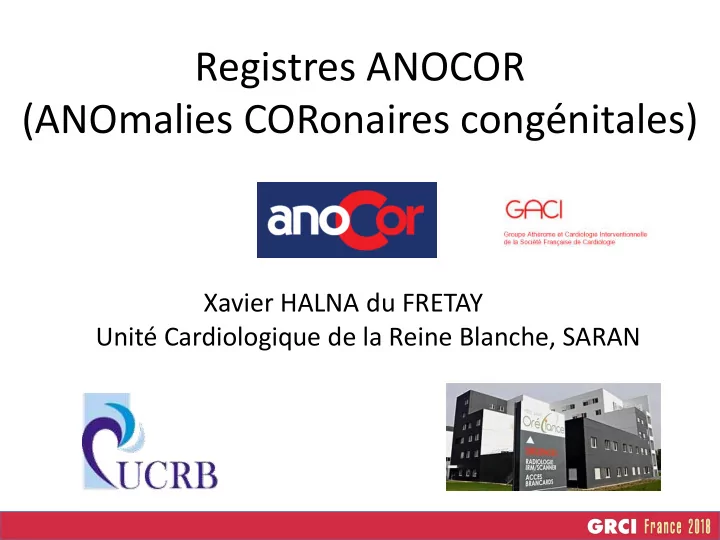

Registres ANOCOR (ANOmalies CORonaires congénitales) Xavier HALNA du FRETAY Unité Cardiologique de la Reine Blanche, SARAN
D ÉCLARATION DE LIENS D’INTÉRÊT AVEC LA PRÉSENTATION Intervenant : Halna du Fretay Xavier, SARAN, FRANCE Je n’ai pas de lien d’intérêt à déclarer
ESC 2015
Koutsoukis et al. Cong Heart Dis 2017
Koutsoukis et al. Cong Heart Dis 2017
Cheezum et al. JACC 2017
Activité staff ANOCOR Docteur Mohamed BACCOUCHE Mémoire DIU cardiologie interventionnelle 2017-2018
50 avis rendus 28 corrections proposées (56%) 13 par angioplastie (46%) 15 par chirurgie (54%) 10 corrections réalisées
Eur Heart J 2016
Evaluation of the hemodynamic impact of different forms of anomalous connection of coronary artery using Computed Tomography derived Fractional Flow Reserve F. Hyafil 1 , J. Adjedj 2 , W. Benadji-Ferrag 1 , C. Kefti 1 , X. Halna Du Fretay 3 , P. Dupouy 4 , P. Ou 5 , JP. Laissy 5 , JM. Juliard 6 , W. Wijns 7 , P. Aubry 6 (1) AP-HP Hopital Bichat-Claude Bernard, Department of Nuclear Medicine, Paris, France (5) Hospital Bichat-Claude Bernard, Radiology, Paris, France (6) Hospital Bichat-Claude Bernard, Cardiology, Paris, France (2) Inserm UMR 702, Cardiology, Paris, France (3) Foch Hospital, Cardiology, Suresnes, France (7) National University of Ireland, Lambe Institute for Translational Research, Galway, Ireland (4) Private Hospital of Antony, Cardiology, Antony, France Figure. A. Representative example of a patient with pre-aortic course of the RCA Background 0.87 A with no significant hemodynamic impact at its origin but bordeline value at the Anomalous connection of coronary artery (ANOCOR) has been associated with adverse cardiac events in young patients. Indications to surgical correction are distal segment of the RCA. based on the initial course of the ANOCOR. Stress tests do often not evidence any B. Representative example of a patient with pre-aortic course of the LM with no myocardial ischemia in these patients; fractional flow reserve (FFR) is difficult to significant hemodynamic impact at its origin but bordeline value at the distal measure invasively in the proximal segment of ANOCOR. Computed Tomography segment of the LAD. derived Fractional Flow Reserve (FFR-CT) is a non-invasive functional test providing anatomical and functional evaluation of the overall coronary tree. These unique features could help to tackle difficult decisions in patients presenting ANOCOR. Mean FFR-CT values were 0.82 ± 0.11 in preaortic, 0.85 ± 0.08 in retroaortic, 0.81 ± 0.16 in subpulmonar, and 0.83 ± 0.12 in prepulmonar courses. No statistical Purpose. difference was observed between the values of FFR-CT measured for the different We aimed to evaluate the hemodynamic impact of different types of ANOCOR 0.80 courses (P > 0.05). using FFR-CT in a large multi-centric cohort of patients. The ANOCOR involved the left main/left anterior descending (LM/LAD) in 10 Methods. patients (17%), the left circumflex (LCx) in 11 patients (18%) and the right coronary The multi-centric ANOCOR registry included 476 adult patients with ANOCOR artery (RCA) in 39 patients (65%). In ANOCOR vessels, mean FFR values in LM/LAD, detected during coronary angiogram or computed tomography (CT). Among the LCx and RCA were respectively 0.81 ± 0.13, 0.81 ± 0.12 and 0.83 ± 0.11 (p > 0.05 for latter 106 patients were evaluated with a coronary CT angiography (CCTA) at the all). Mean FFR-CT value was measured at 0.90 ± 0.09 at the end of the abnormal time of inclusion. Patients with anomalous connection from the pulmonary arterial course of the ANOCOR vessel. Mean FFR-CT value measured at the distal segment trunk were excluded from the analysis. All CCTA were sent to Heartflow for of the ANOCOR vessel was significantly lower compared to the value measured in extraction of FFR-CT values in ANOCOR and non-ANOCOR vessels using their the non-ANOCOR vessels (0.83 ± 0.10 vs. 0.87 ± 0.09, respectively, p = 0.0003). dedicated software. B Results . FFR-CT values could be obtained in 60 patients; 56 patients could not be processed because of insufficient image quality. Mean age of patients was 58 ± 14 years, 47 Conclusions. FFR-CT demonstrated a moderate hemodynamic impact on coronary flow of the (78%) were male. Preaortic (so-called interarterial), retroaortic, subpulmonar and prepulmonar different forms of ANOCOR including the preaortic course, but FFR values remained courses were observed respectively in 34 (53%), 16 (27%), 6 (8%) and 4 (8%) superior to the 0.80 cut-off value in most of the patients. Long-term follow-up of patients. patients included in this cohort is on-going and will help to define whether FFR-CT might help to improve risk stratification in the ANOCOR population. Acknowledgements The organization of the ANOCOR cohort is supported by a grant of the French Society of Cardiology. We wish to thank Heartfow for generously providing the FFR-CT measurements for the patients included in this study. 0.78 ESC 2018
Coronarographie que Vue dans son plus petit axe Vue dans son plus grand axe
Echographie endocoronaire Scanner coronaire extramural ostium juxtamural intramural
30 ANOCOR (5 gauches/25 droites) 7 FFR ≤0.80 (23%) 23 orifices en fente (77%) 12 corrections ANOCOR (40%) Driesen et al. Cathet Cardiovasc Interv 2018
Stout et al. JACC 2018
J Thorac Cardio Surg 2017
Série chirurgicale, n = 31 CHU Necker M GAILLARD ,Thèse 2017
JE SFC 2018
Conclusions ANOCOR à risque potentiel : non exceptionnelles. Trajets ectopiques parfois mal identifiés : intérêt de centres référents. Critères de sévérité des ANOCOR à risque : à mieux préciser. Attitudes pratiques et recommandations : parfois décalées. Angioplastie : alternative à la chirurgie ?
Registres Registre publication en 2019 Registre -STENTING en cours Registre -RISK début en 2019
Staff mensuel ANOCOR contact pcaubry@yahoo.fr groupe de travail multidisciplinaire de travail sur les anomalies coronaires congénitales Pierre Aubry Philippe Degrell Patrick Dupouy Warda Ferrag Xavier Halna du Fretay Fabien Hyafil Jean-Michel Juliard Jean-Pierre Laissy Phalla Ou
Recommend
More recommend